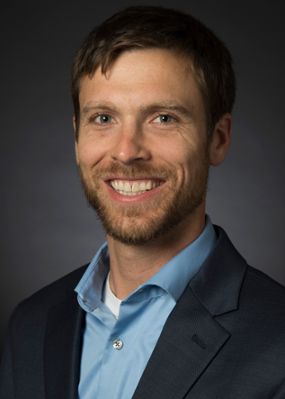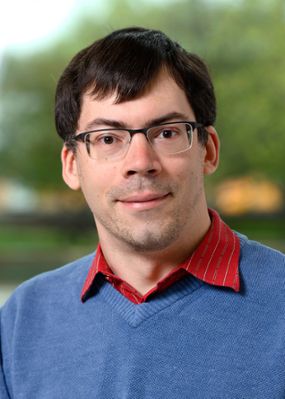Two Michigan State researchers awarded 2022 Sloan Research Fellowships
Michigan State University researchers Dalton Hardisty and Ilya Kachkovskiy will each receive a prestigious, two-year, $75,000 Alfred P. Sloan Fellowship in recognition of their accomplishments as early career scientists with exceptional promise in their fields.
This year’s cohort of 118 Sloan Research Fellows come from 51 institutions throughout the United States and Canada. Hardisty and Kachkovskiy join the list of renowned scholars who have received Sloan Fellowships since launched in 1955, among them 41 MSU faculty members and 53 Nobel Prize winners.
“Recognition of our early career faculty by an organization such as the Sloan Foundation is a testament to the caliber of our researchers at MSU,” said Doug Gage, vice president for research and innovation at MSU. “Not only will the Sloan Fellowship support their work, it will position their career trajectories for future success.”

Hardisty, an Endowed Assistant Professor of Global Change Processes in MSU’s Department of Earth and Environmental Sciences, or EES, in the College of Natural Science, or NatSci, studies paleoceanography and geochemistry. Using the geochemistry of sediments, his lab investigates the co-evolution of ocean chemistry and biology throughout Earth’s history — from billions of years ago to modern times. Hardisty is a leading expert on oxygen in the ocean and environmental iodine cycling. He studies modern low oxygen environments to learn more about ancient oceans where this condition was more widespread.
“I’m excited and honored to receive this fellowship. I have a lot of gratitude as well,” Hardisty said. “My current group of graduate students and postdocs as well as peer collaborators at MSU and other institutions played a major role in this. I’ve also had great mentors over time. In many ways, it’s a recognition of the integrated efforts of all of these people.”
With the funds from the Sloan fellowship, Hardisty plans to examine the conditions of marine iodate accumulation expected for Earth’s earliest oxygenation roughly 2.5 billion years ago. He also plans to build a geochemical database and framework for understanding trends in carbonate mineral abundance — particularly dolomite — in the Precambrian. Hardisty and his colleagues are creating the records modern scientists use as baselines to recognize the extent of change that exists today.
“Dalton is one of the most capable young researchers in this field, and the Sloan award is a great recognition of his accomplishments so far and his future potential,” said Jeffrey Freymueller, EES department chair. “Dalton’s Sloan fellowship contributes to a string of recent awards and successes in the department. These collectively point to a growing chorus of recognition of the national and international impacts that our department is having on the Earth and environmental science community.”
“Dalton has a remarkable ability to move up and down the geologic time scale, with questions and important answers about the co-evolution of Earth’s oceans, atmosphere and life that span millions and billions of years,” added Timothy Lyons, Dalton’s doctoral adviser and Sloan fellowship nominator. “He brings rigor and innovation to novel chemical fingerprints of conditions on the ancient Earth, often validating and calibrating his methods through studies of the modern oceans. Among his most important contributions are new insights about settings on modern Earth lacking oxygen — a condition that may become more common in our warming oceans — and how and when oxygen first accumulated billions of years ago.”

In 2017, Kachkovskiy came to MSU as an assistant professor in the NatSci Department of Mathematics. He works in a branch of mathematical physics called spectral theory and is developing and using meticulous mathematical methods to study models of quantum particles that originate from quantum mechanics and solid-state physics. Currently, Kachkovskiy is studying the behavior of electrons in crystals and quasicrystals to determine whether an electron would be able to move freely (delocalized) or be bound to a certain location (localized). He’s developing new techniques to show that electrons will be localized in some quasiperiodic environments.
“Personally, it’s a great honor to receive this award,” Kachkovskiy said. “Professionally, this will allow me to have more flexibility with balancing my teaching, research, travel and support of graduate students and postdocs.”
Keith Promislow, mathematics department chair, nominated Kachkovskiy for the Sloan fellowship believing his work has the potential for significant scientific impact. Kachkovskiy uses rigorous analytical techniques to solve hard mathematical physics problems. He also notably completed two important Ph.D. theses simultaneously.
“Dr. Kachkovskiy’s record of publication and external funding place him as an international leader in the important field of transport in disordered media,” Promislow said. “The Sloan Research Fellowship cements his stature as he turns his attention to applying his breakthroughs in fundamental mathematics to address pressing problems in quantum information theory. Dr. Kachkovskiy’s success highlights MSU’s essential role in supporting fundamental research that changes the world.”
The highly coveted Sloan Research Fellowships are open to researchers in seven fields: chemistry, computer science, Earth system science, economics, mathematics, neuroscience, and physics. Fellows are announced in February and added to the Sloan Foundation’s database in April.
For a complete list of 2022 Sloan Research Fellowship award recipients, visit the Sloan Foundation’s website.
Banner image: This composite image represents the research of MSU’s 2022 Sloan Fellows Dalton Hardistry, who studies ocean geochemistry, and Ilya Kachkovskiy, who develops mathematical models for complex physical systems. The image shows a sunset over the ocean where the sun has been replaced by a pattern made by electrons diffracting from metallic quasicrytals. Credit: Materialscientist via Wikimedia Commons (diffraction pattern) and Joseph Barrientos via Unsplash (ocean sunset)